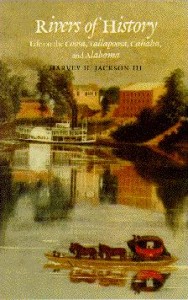Here are a few books, in no particular order, that you may find interesting, broken into a few categories like Lake Martin History and Lake Martin Flora and Fauna and others. If you have any that I need to read, or disagree somehow with my picks, please email me and I will be glad to check them out.
LAKE MARTIN HISTORY:
Memories of the Mount: The Story of Mt. Meigs, Alabama by John Scott, Jr.
This book mostly is about the tiny village of Mount Meigs, Alabama, which is east of Montgomery. But Mount Meigs’ history is intertwined with the Tallapoosa River so much that I learned a lot about the Lake Martin area when I read it. He has excellent descriptions of life from when this entire place was “owned” by the Creek Indian Nation, then later by Alabama’s earliest settlers, on up to the modern era. Mr. Scott is a great writer, very accessible yet factual. I knew I would like the book when I read the first paragraph. I love his chapter titles, e.g. “Of Cotton.”
Rivers of History: Life on the Coosa, Tallapoosa, Cahaba, and Alabamaby Harvey H. Jackson, III.
This is another great book that lays out how life was like “back then” – from the Indian days to the current days of impoundment. As a local, and one decidedly biased towards Lake Martin and the Tallapoosa, I could argue that he spent way too much ink on the Coosa, and even slighted the Tallapoosa by calling it less glamorous or impactful of a watershed. The building of Martin Dam, which at the time created the largest man made body of water in the US, receives scant attention compared to the various locks, spillways, and beaver dams that dot the Coosa. I should have expected as much, the author disclosed that he is from Wetumpka. Seriously, this is a good book. I really liked it. In reality it covers a great deal about the Alabama River, which is formed by the confluence of the Tallapoosa and Coosa. The author is well researched, writes very clearly, and inspires one to read more of the subject.
Putting Loafing Streams to Work: The Building of Lay, Mitchell, Martin, and Jordan Dams by Harvey H. Jackson, III.
Until this writing, I did not realize that this book was by the same author as Rivers of History. No wonder, then, that for years I have held the same gripe with this book, that much too much time is spent talking about dams other than Martin. True, Jordan Dam was built in areas with cool names like “The Devil’s Staircase” – but the sheer technology, engineering, and city building that was needed to build Martin Dam makes all the rest of these dams look like weekend Boy Scout projects by comparison. I guess that I am going to have to be the one to write a book to set the record straight – that the Tallapoosa – and therefore Lake Martin – is way cooler than anything around. When I do write it, you can bet your bottom dollar that I won’t be published by the U of Alabama Press. Ha!! But seriously folks, this book is another must buy to have laying around the lake home. He has excellent photos of construction era workers, plans, everything. Our copy of this book is creased at the page that shows the old Kowaliga Bridge before Lake Martin filled up. It is amazing. And the pictures of the dam workers’ barracks etc. are outstanding. He also does a really good job of explaining the background of Alabama Power, and how they came up with the idea, raised money, and built dams all in 10 or so years, back when most people didn’t have any electricity. Say what you want about Alabama Power, but the sheer magnitude of how they changed lives for the better in rural Alabama in the early 1900s is without debate. Can you imagine a single private company doing that today? I still am in awe.
Books On Lake Martin Area Flora And Fauna
These books should help you navigate your way around Lake Martin’s wildlife. I own and love most of these. A couple of them I haven’t read but want to! Some of them might contain data that applies elsewhere also, but all are applicable to the central Alabama area.


